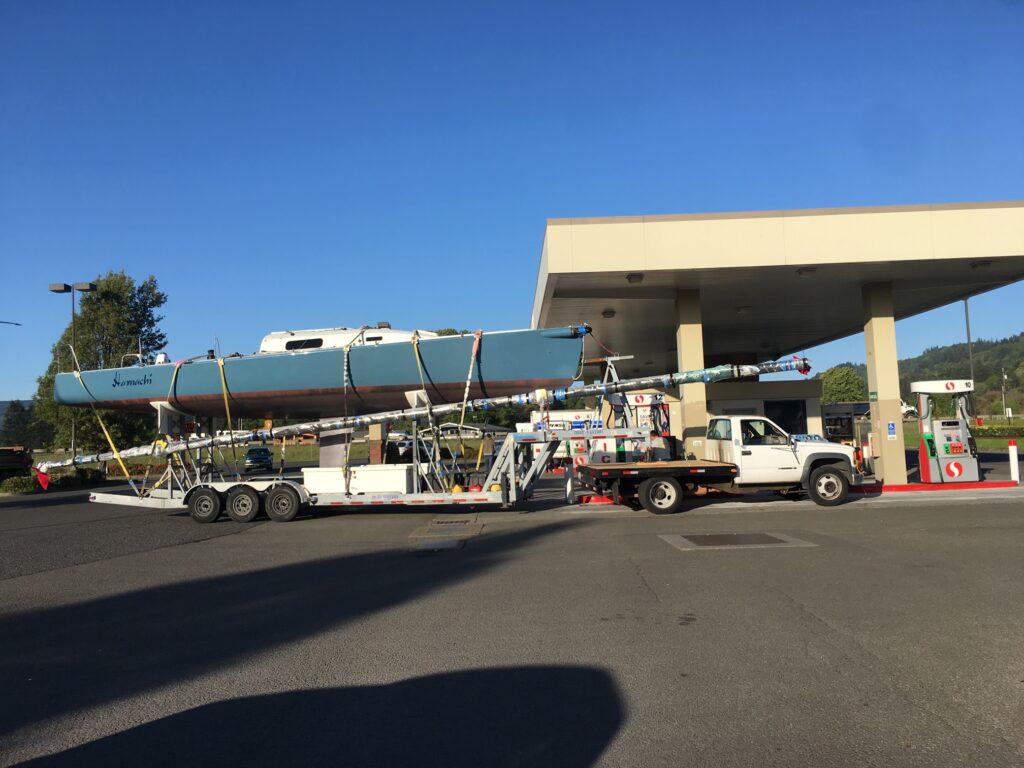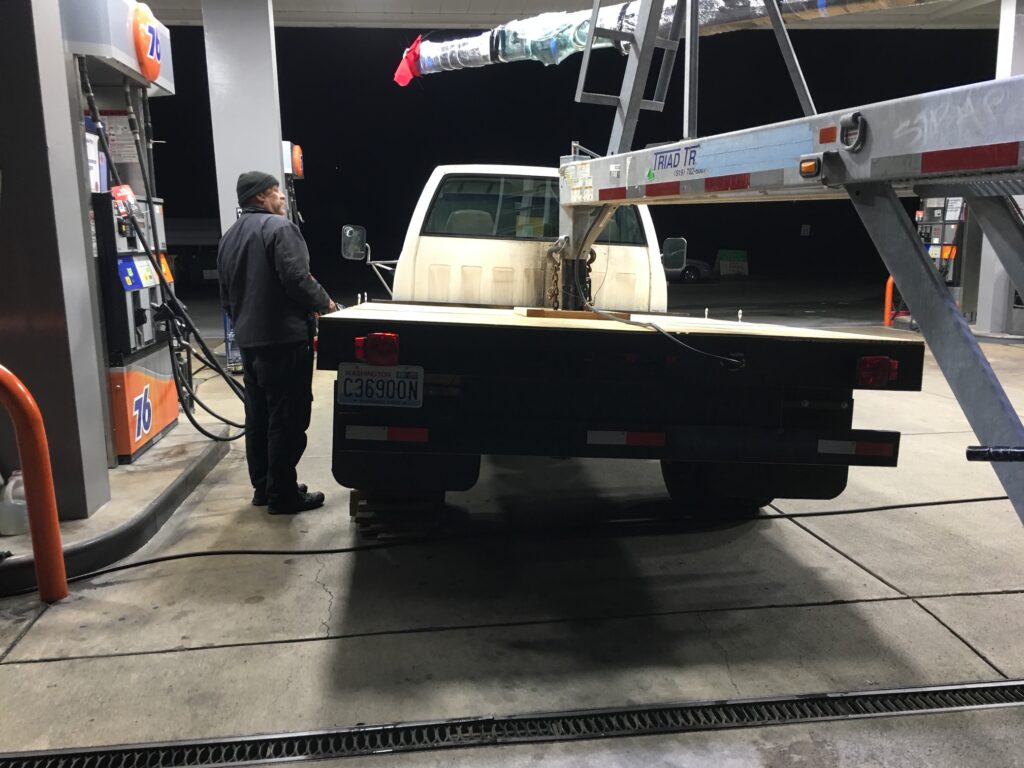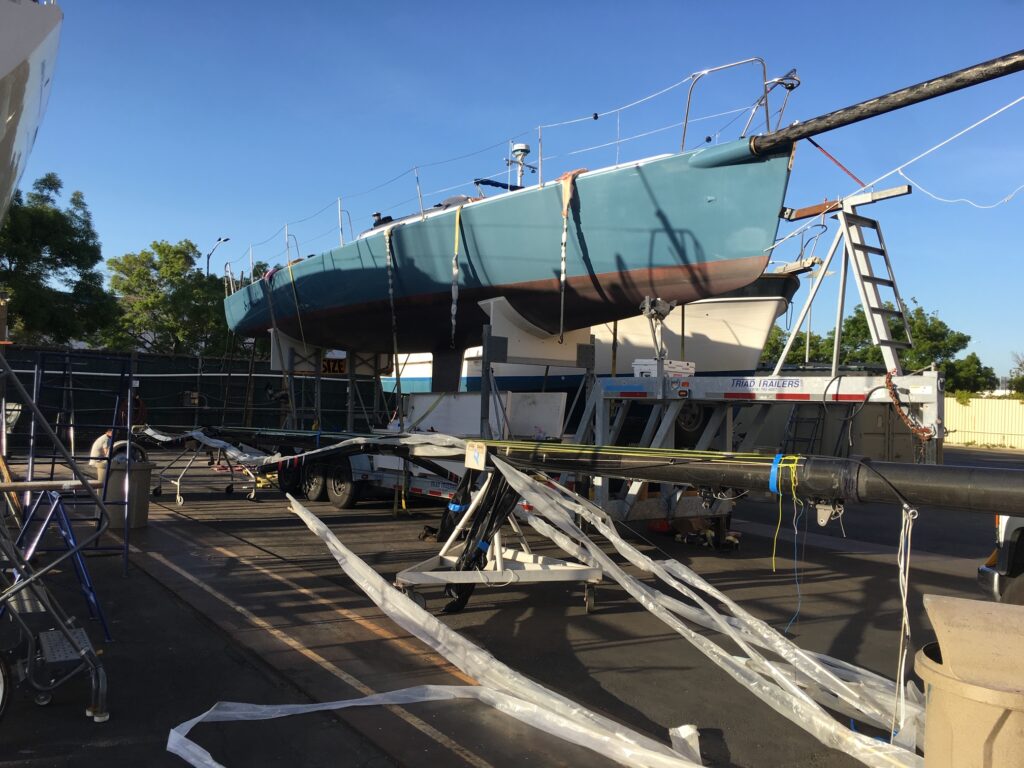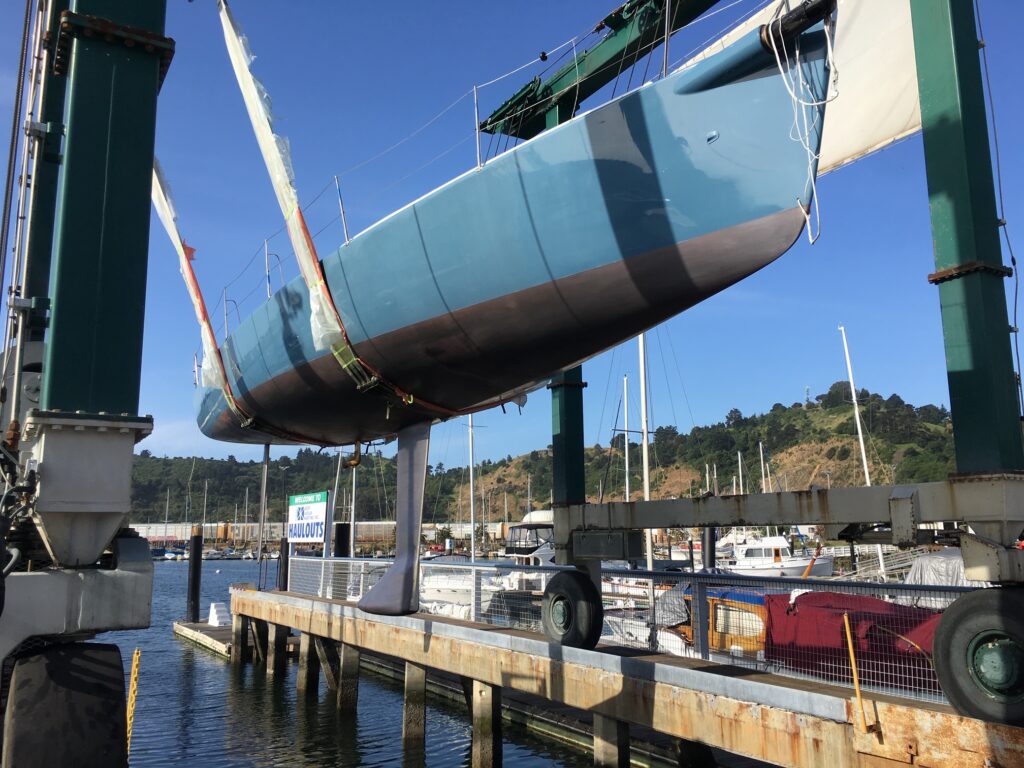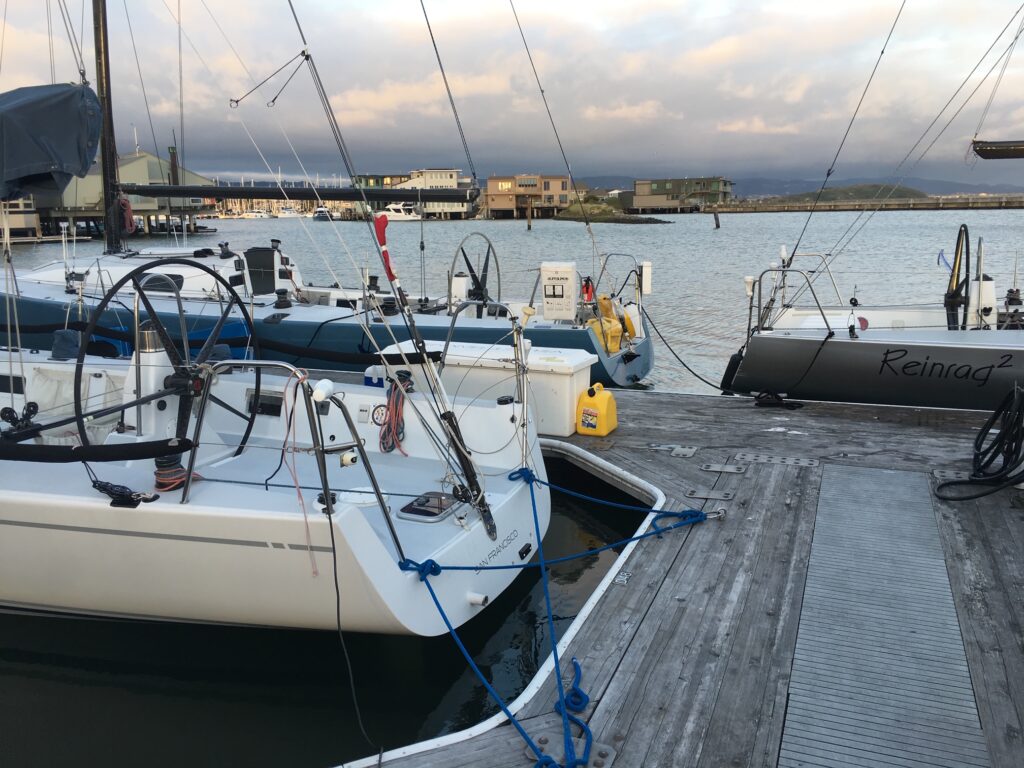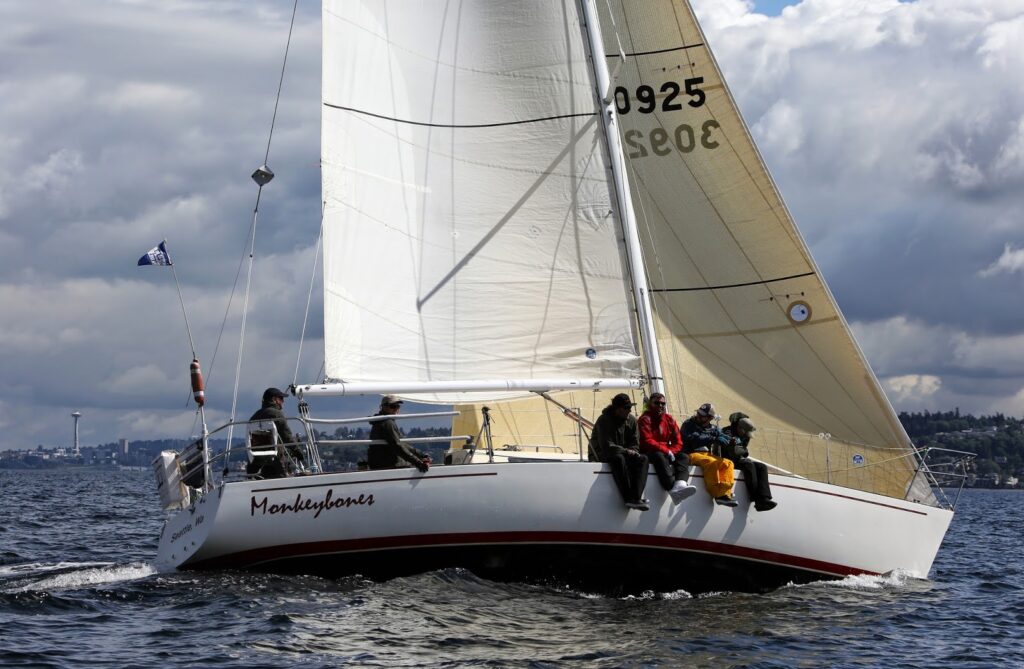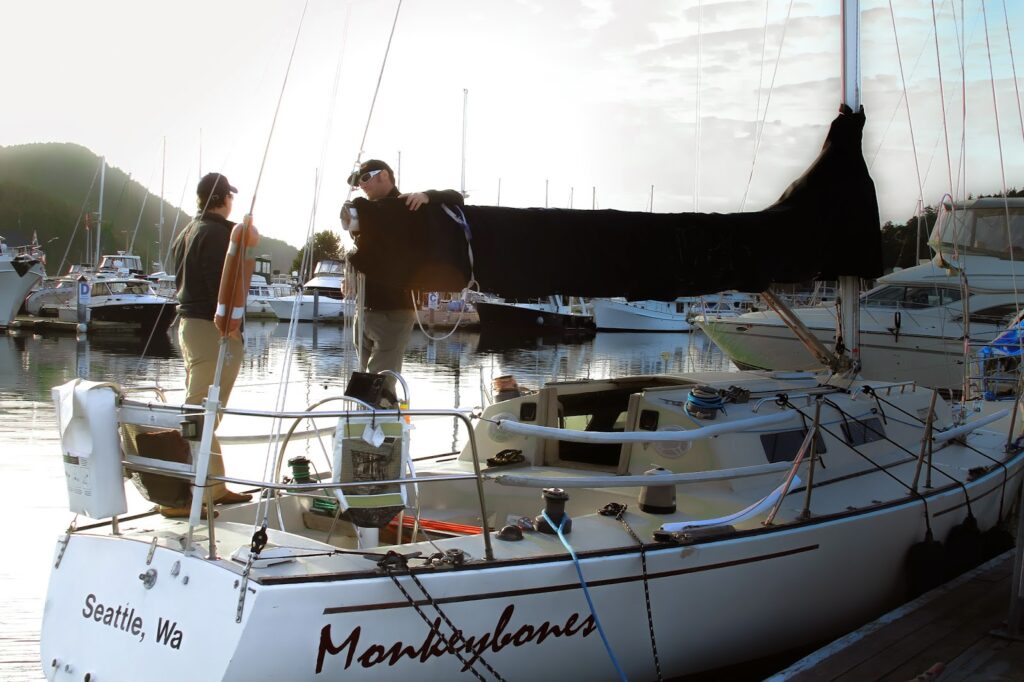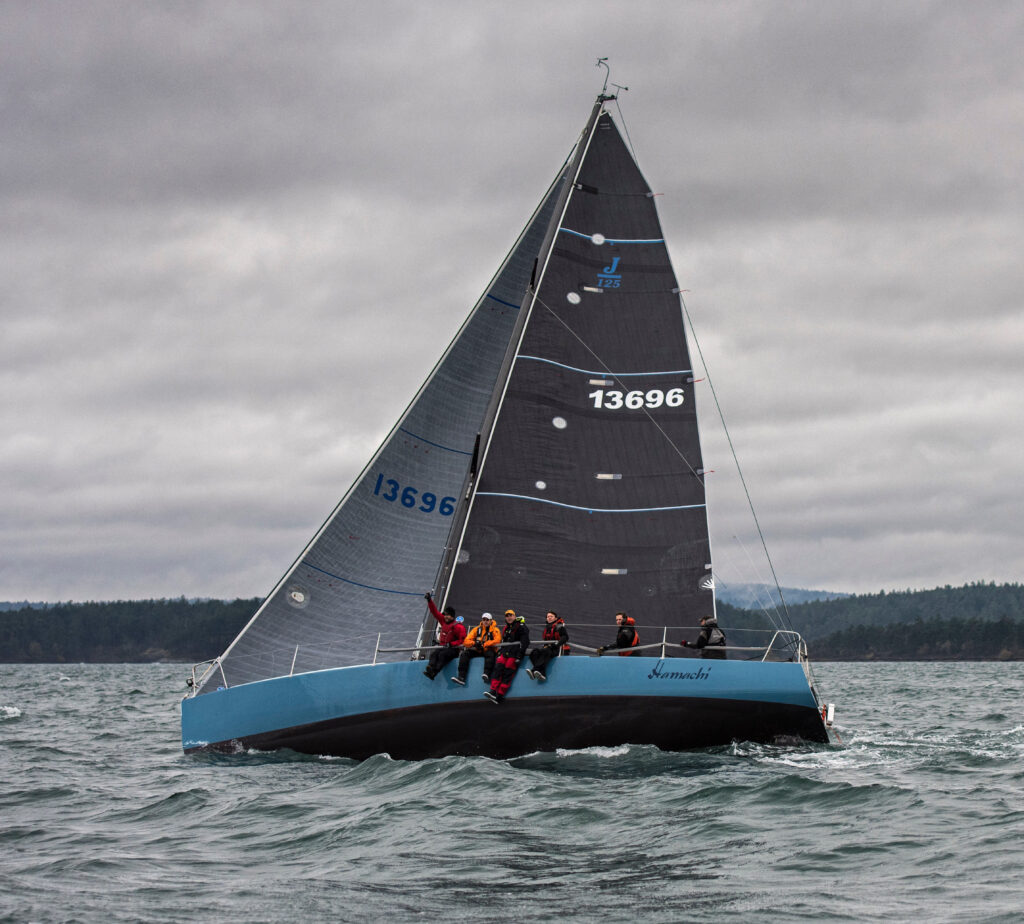Part 1 - The Journey to Transpac
Part 2 - Preparing the Boat and Crew
Part 3 - The Race
Part 4 - Winning Transpac
The Hamachi Transpac crew began arriving in southern
California on July 6th ahead of our July 12th start to
attend mandatory crew briefings. While perfunctory, looking around the room
made it clear that this was not your local race - in attendance were some of
the best crews and skippers from around the World. We enjoyed the pre-race
party and connected with crews from t Draconis (Rogers 46 from Japan)
and Comanche (100ft from Australia). Afterwards we returned to Marina
Del Rey and the California Yacht Club for final Hamachi preparations.
The first order of business was to pack the boat for minimum
weight. By now we had learned that the other three J/125s were sailing with
five crew. We were going to sail with six. An additional person amounts to 300 lbs
of additional weight between the body, gear, food and water. Someone had
already calculated that 1 additional pound of weight amounted to 30 seconds in
your finish time, so an additional crew member meant 150 minutes (2.5 hours), which is significant. As a result, we
attempted to make up this excess by cutting everywhere else. We stripped the
boat clean and looked at every piece of gear, and only put it back on board if
it served two or three critical functions. We had enough weather insight to
select final sails, and decided to forgo all light weather gear. We agonized
over final sail selection and decided to go with our lighter inshore main (with
one reef versus our older offshore main with two reefs), all purpose (AP) J1,
reefable J3 (capable of reefing to a J4), spinnaker staysail, genoa staysail,
Code Zero, and the following spinnakers: A4, A3, A2.5A (older), A2.5B (newer)
and A2.0. We left the A1.5 on the dock
and rounded out the sails with obligatory storm trysail, storm jib and heavy
weather jib.
Hamachi had sat in her slip for almost two months and
was in dire need of a hull cleaning. We
had arranged for a final haul out at a local boat yard and were surprised to
see a heavy coral-like growth covering her entire bottom from local tube worms.
Scrubbing was not effective, and we wound up sanding her bottom clean. This
last-minute gear optimization and hull cleaning proved critical as she came out
of it light and fast. She went back into the water two days before our
designated start on Friday July 12th and we motored her down to San
Pedro to be with the rest of the fleet pre-start.
Not fast...
Definitely not fast...
We spent a full day of hard labor preparing Hamachi
Hamachi motored out to observe the first Transpac
start on Wednesday July 9th.
This was our last training sail and provided a great opportunity to
understand the start and start tactics. We flew the drone and had great video
of the first day starters. We then put up sails and wound up on a crossing course
with Comanche (a 100ft sled and the fastest monohull on the planet), who
was out for more tune up. Relishing the opportunity, we hastily launched the
drone for more video. Unfortunately, in
our rush we did not wait for GPS lock, and the drone went crazy once airborne.
It switched to visual flight references and was confused by the wave pattern in
20 kts of breeze so went rocketing down-wind past our backstay, nearly missed
our main sail and crashed into our spinnaker, which sent it careening into the
Pacific Ocean. The crew was crushed, but we vowed to buy another for our sail
across the Pacific. We finished up our test sail, calibrated our speedos, and
parked Hamachi till the start.
Our expensive encounter with Comanche.
The last day was spent checking weather, packing food and
buying a new drone (hint: you can buy a MavicAir at Best Buy).
Friday – July 12th
We went to bed early and awoke the morning of the race with
a list of final activities. We had a large breakfast, although pre-race nerves
made it hard to eat, and went to the boat for final packing, a quick bottom
cleaning, and crew pictures. We wished our fellow J/125 competitors luck (each
team put $125 into a purse for the first boat to reach Hawaii) and motored to
the start line. Leaving the harbor our impressive fleet of 40-60 ft sleds motored
past the final day starters, which included all of the big sleds (e.g.Comanche,
Pyewacket, Merlin) and multihulls (e.g. Maserati, Argo), knowing they would
come to chase us down the following morning.
For the 50th running of Transpac 92 boats made it
to the start line, which was a record (by a large margin). As a crew, we had three
goals: be safe, have fun, and win (in that order). “Winning” meant beating the
other three J/125’s and taking the Transpac award for best on-the-water
reporting by submitting a video prior to finishing the race. We had no
expectations of doing more than that.
Team Hamachi departing for Hawaii!
The morning June Gloom (low clouds and haze) was starting to
lift for our noon start and the wind was out of the northwest at 6-8 kts.
Unfortunately we were having instrument issues: despite calibrating both
speedos the night before, the port speedo, which is the most critical for the
race, was suddenly non-functional. We spent the entire pre-race troubleshooting,
to no avail – it was non operative the entire Transpac. As a result, we never had a good sense of our
boat speed, which given the final outcome is ironic.
Hamachi was officially in Division III, which
consisted of 13 boats, and was part of the second start, which had around 40
boats. With the exception of Longboard (Riptide 35 from Vancouver, BC),
we were the smallest boat in the day 2 start. Our strategy was to avoid the log
jam of larger boats at the favored pin end of the long line and instead start
near the middle. We found a clear lane amongst our J/125 fleet and started on
starboard. We were almost immediately fouled by the J/125 Snoopy, who
tried tacking across our bow on port in search of clear air, and were forced to
duck them when they didn’t yield. Annoyed, we continued on, pointing high and
fast with full main and J1AP, quickly establishing a lead on the J/125 fleet
while even passing a few Santa Cruz 50s.
The Transpac fleet must round the northern tip of Catalina
Island and we missed laying it by 100 feet, which forced us to tack upwind in
light conditions. We lost our lead but focused on our strategy, which was to
sail north and get high on our competition heading into the first night. This
would allow us to transition early to our Code Zero and, with more speed, “zoom
down” onto our fleet, hopefully passing them on Day 2. Our goal was to get
below (south of) them before entering the “slot cars”, the critical middle
portion of the race. A southern position kept us away from the high pressure
and its lighter pressure, but also gave us the option to sail north if there
was better pressure.
Our watch rotation was 4 hours on/off with short 2 hour
shifts between noon and 4pm. This
allowed the watches to alternate every day, so no one watch was stuck with the
dog watch (midnight to 4am) the entire race. We stood our first watch at 4pm
with Port (Jason, Fred and Lucas) taking the helm while Starboard (Shawn,
David, Matt) went below to rest. As the sun set on Friday (night #1), the wind
built and slowly moved right to a true wind angle of 55-60, which allowed us to
deploy our genoa staysail inside the J1AP. Hamachi rumbled along at 8-9
kts in 15-20kts of wind through wind chop on top of an ocean swell, which made
for uncomfortable conditions and some crew succumbed to sea sickness. The first
night watch with extremely wet, rough and dark conditions was a shit show with
the crew in survival mode. Welcome to Transpac.
Saturday - July 13th
The port watch came back on deck at midnight and we found
ourselves abeam of Snoopy (J/125). The clouds parted to reveal a waning
near-full moon and the fresh crew put the hammer down, steadily pulling away.
While initially concerned about the weight of our extra crew member, we discovered
after the race that having an extra person was instead a clear advantage. The
other J/125’s were sailing with a navigator and two 2-person watches. With
three crew on deck we set up 45 minutes rotations between driver, main trim and
jib/spinnaker trim so that everyone remained fresh and alert. The other two person
watches could not do this and we wore them down over the course of the race,
making our biggest gains at night. In addition, the other J/125s only had one
navigator that would alternate between the two watches. On Hamachi David was the primary navigator
with Jason in a supporting role and serving as tactician (with Fred). They were
intentionally on opposite watches to maintain continuity and situational
awareness.
Hamachi hammered through the night and into the
morning, alternating between full and reefed main with our J1AP and genoa
staysail (GS). We struggled early with race situational awareness as all boats
slowly switched off their AIS transceivers, and it took us a bit to figure out
how to download Yellowbrick position reports via our Iridium GO modem. Because
we didn’t know where the other boats were (yet), we sailed our race.
We sailed fast with the J1AP and GS and probably should have
shifted to our Code Zero sooner than we did. However, as soon as we set the
Code Zero around 3pm on Saturday, we came roaring down and over Snoopy,
who had sunk to the south. We blasted along beam reaching at 11-12 knots in
16-20 kts of wind through the afternoon and into the evening. That night we
bombed along under broken clouds thoroughly enjoying the majestic stars and
near full moon.
Sunday - July 14th
By the midnight watch change the wind was shifting farther
and farther right. We decided it was time to peel to the A3 spinnaker and
sailed high and hot until 5 am, at which point we peeled to the A2.5B (the
newer of our two used A2.5s). By daybreak the wind was starting to
lighten. Further, the weather gribs were
showing areas of further lightness to the south, so we sailed hot angles to
climb into the slightly better wind to the north. We spent all day working to
keep the boat rumbling in 10-15 kts of wind.
Now under spinnaker and in lighter winds the boat flattened
out and we were finally able to open her up and dry her out. By now all the
crew had their sea legs and were finding their groove. We were also starting to
get our communication rhythms down: pulling gribs on a regular basis,
downloading yellow brick position reports, and sending out email updates out to
our Race Boss Janet Laffitte for reposting on the Hamachi Facebook page and
sailish.com. While our primary race positioning was still coming from the
Transpac morning position reports, we were starting to get a sense for where
the other J/125’s were, as well as the leaders in Division III. We spent most
of Sunday watching Velvet Hammer, who had appeared from the north
sometime in the night, pass over the horizon off our stern.
It was on Sunday that we decided to do our first (and only)
rig check. We launched both the drone and Matt Pistay up the rig, capturing
great footage of him jumping over the spinnaker to clear a trapped spinnaker
halyard.
Monday – July 15th
By Day 3 of the race we were into our routine of sail,
sleep, eat. As we approached the trade winds the solid marine overcast was
breaking up into puffy clumps of clouds and the water was warmer. The wind was
slowly clocking further right, but we were under our A2.5 spinnaker and in our
“slot”, meaning our position on the course was mostly fixed: we couldn’t sail
any deeper (i.e. south) and could only work up towards boats to the north. That
was our original plan: keep our competition to the north as we entered the “Slot
Cars”; and we were happy that it worked out.
As a result we slowly turned right to match the wind and
maximize boat speed. The crew of Hamachi sailed hard, fast and fun. Each
watch was pushing the boat aggressively to find planning conditions. Our goals
for the race were modest: we were more focused on getting to Hawaii and
enjoying the adventure than any results; and I believe this became one of the
team’s key strengths. We had invested in real food having pre-made and frozen
individual meals that were stored in Styrofoam coolers organized by day. A fun
and well fueled crew is a very fast crew, and it paid off during this portion
of the race.
Tuesday – July 16th
We woke up to learn that Hamachi had climbed the ranks and
was now second in Division III and third overall. We were frankly shocked.
“What…??!!” was the general response. “Can you double check that?” We had, to
date, spent our efforts tracking the J/125s, not really caring about the bigger
picture. Continuing with that approach, the team shrugged it off and went back
to sending it across the waves.
Tuesday was a truly epic day as the wind built to 20+ kts
and the crews kept the boat on the ragged edge, working to milk every last knot
of speed. We were rocketing along in our slot with no thought of jibing south,
since we were clearly on the favored board. It was all about boat speed and the
ride was wet, wild and loud. We blasted through the afternoon and into the
evening. While more casual during the day, there was a strict life jacket and
harness policy from sunset to sunrise, and the night watches clipped in and
kept the hammer down.
Team Hamachi in the groove.
Wednesday – July 17th
The morning fleet report had Hamachi covering 327nm
towards Hawaii in the previous 24 hours, which propelled her into first place
in Division and Overall. This could be a J/125 single day record.
We suddenly realized that something special was happening.
That morning we crossed in front of t Draconis, our
newfound Japanese friends on a Rogers 46, and were in the vicinity of much
faster boats from our start. Around noon we calculated that we had crossed, or
were at least close, to the half-way point, and frankly shocked that it
happened so fast. We pulled out our small flask of Knob Creek bourbon, put on
the tunes, launched the drone, and had a short but epic dance party in the
middle of the Pacific Ocean. The Hamachi Transpac video captures the
crew dancing to YCMA and truly enjoying the moment.
Ripping across the half way point - 1100 miles from land.
We continued ripping along in 15-20 kts of wind while trying
to assess the weather and where the rest of the fleet was. Our lead over the
other boats was 20 to 50 nm. The gribs had been showing more pressure to the
south, with about 2 kts more wind. While minimal, Hamachi’s boat speed
had been averaging 2 kts less than wind speed. If one of our competitors had
two more knots of wind, and hence boat speed, it meant they could gain 50 nm on
us over a 24 hour period, which would erase our lead. Around noon we downloaded
Yellowbrick data and saw that both Snoopy and Velvet Hammer had
jibed south, presumably to go after the better breeze. We also knew that these
position reports were four hours delayed, so it was conceivable that they were
already 50-75 miles to the south of us and half-way to the better wind.
Complicating matters, it appeared that the wind would start backing off, beginning
from the north, as the fleet sailed closer and closer to the high.
Historically, we have been the underdogs and love the
pursuit role. Hamachi was now the lead boat and everyone was gunning for
us. Transpac was our first ocean race and we felt very uncomfortable being 1250
miles from the finish and engaged in a high stakes chess match to cover a fleet
spread over hundreds of miles.
The tactical / navigation brain trust of Jason, Fred and
David talked it over and we were split. We had reached the point in the race
where you transition from “slot cars” to “downwind to Hawaii”, meaning that the
wind was even on either board to Hawaii (one direction was not favored versus
the other). Based on what we knew, Bretwalda (the race favored Rogers 46
in our Division III) was still on our board but the trend was that all J/125’s
would correct ahead of them. Fred and David said we should continue and push
for the far (right) corner of the course, which has historically proved to be
the advantage. Jason was concerned about the easing local breeze and stronger
pressure to the south, and felt we should cover the other J/125s. In the end
Fred said it best (to Jason), “you are writing the big check, it’s your
call”. Jason chose to go south, so we
jibed.
As soon as we jibed south the instruments, which were most
likely being impacted by the non-working speedo, showed that we were now on the
unfavored board. Regardless, we said we
would sail south through one watch and reassess. As we moved south the wind did
build into the low 20s, along with the sea state, and the Starboard watch had
some epic blasts down massive ocean swell. We spent eight agonizing hours sailing
south, second guessing our tactical calls, before jibing back west onto the
(maybe) favored board at the 8pm watch change. Hamachi sailed into a
dark night and the wind increased further.
At 17 kts of wind, Hamachi can jump onto the step and
race down a wave at 16-18 kts. You can then surf in the trough but can’t typically
get up and over the next wave. As a result, the boat temporarily slides off the
step until the process is repeated on the next wave. At 20 kts of wind Hamachi will race down a
wave then climb up and over the next wave at speed. That night the wind cranked
up into the mid-20s and Hamachi was an out of control freight train. At
those wind speeds the boat would rocket down the face of the wave and plow into
the back of the next one or, if unimpeded, race up the back of the next wave
and launch off the top, crashing many feet down into the trough of the next
swell. Both scenarios produced walls of water that engulfed the boat. During
the day, when you can see the waves and position the boat, it’s exhilarating. But
in the pitch black, with the moon and starlight erased by a heavy cloud layer, you
are sailing by brail and it was a little terrifying. Our one working speedo was
out of the water half the time, which made the wind instruments useless, so we
are not sure of the actual conditions, but we went back and saw GPS boat speeds
of 23 kts. It took all our energy and concentration to keep the boat from
wiping out and thankfully the wind backed off after two hours of crazy
conditions.
Thursday – July 18th
We were now in the final phase of the race: the downwind
into Hawaii. We were also out of frozen food and into the freeze dried, which
meant we were ready to get to Honolulu. As forecasted, the wind was down to
around 15 kts that morning and we were heading back south on a port jibe. As
the sun cracked into the eastern sky Fred decided to go fishing. He REALLY
wanted to catch a Mahi Mahi and this seemed like the time to try. We towed a
lure for an hour, but conceded that we were going too fast.
As the day developed lines of rain squalls appeared on the
horizon and the sea state increased. These squalls presented a new challenge
because they can bring intense favorable as well as unfavorable winds. The
cloud bands themselves travel with the trade winds. The rain bursts create
downdrafts that work to increase or negate the prevailing tradewinds. The key is to get in front of the squalls to
grab the good wind, and then “bail out” on a port jibe to avoid the dead zone
behind. We spent the day rocketing downwind with the deck awash from the big
seas, chasing and avoiding squalls and occasionally getting a much needed
freshwater soaking.
We generally worked “downhill” towards Hawaii jibing with
our three person watches on favorable wind shifts. We later learned that the
other J/125’s would only jibe at watch changes because they felt they needed
full crews on deck. They were all following us on the Yellowbrick tracker and
our constant jibing was driving them nuts. We attribute our boat handling
skills to the amazing crew and the long Pacific Northwest sailing season, which
provided more on-the-water experience with our boat.
By Thursday evening we were still holding onto our overall
and divisional lead, but everyone was maneuvering to get leverage on us. We were most focused on Velvet Hammer
(J/125), but our cat and mouse games were allowing Bretwalda (Rogers 46)
to start legging out on both of us, which reduced our lead.
We had been pushing the boat and the equipment to the edge.
Due to overly aggressive sailing, and general lapses in concentration, we had
numerous wipeouts and many more spinnaker collapses over the previous five
days. Around 10pm on Thursday evening
our A2.5, which had transported us 1500 nm across the Pacific (and a veteran of
a previous Pacific crossing), suffered one too many indignities and blew up
trying to refill from a spinnaker collapse. The pieces of the sail settled into
the water, and immediately submerged, creating a giant boat anchor. The off-watch
crew jumped from their bunks and on deck in their underwear and it took the
full crew to wrestle the spinnaker remnants into the boat. It was blowing 15-20
and Hamachi wanted to continue on at 8-10 kts, which made this effort extremely
difficult. Knowing that we were pushing the gear, we had the A4 spinnaker
packed and ready to go. We got it deployed and the boat settled, but the sail
did not fly nearly as well as the A2.5.
Friday – July 19th
The Port watch came on deck for the Dog Watch and sailed
with the A4 for a few hours. The wind started to fade and we decided to put the
reserve (even older) A2.5 up. This helped with boat speed but we lost many
miles to our competition during this period. Our misfortune continued with the
Starboard watch when they got overtaken by squalls in the darkness, which
becalmed the boat. By the time the Port watch came back on deck everyone was
tired and frustrated, and the morning fleet position report showed our lead
narrowing. Our happy fun boat was feeling the stress of trying to hold off the
entire Transpac fleet for 1000 miles.
We were slowly closing in on Hawaii and the fleet was both
converging and positioning for the approach to the Molokai channel. We were
split between chasing Bretwalda, who was making gains on us via a direct
course to Hawaii, and Velvet Hammer, who was now pushing towards the
western corner of the course, setting up for a final flanking maneuver into the
finish. Throughout the day we tried to jibe west, but the favored wind angle
kept pushing us back south.
Based on our boat speed and Expedition routing we thought we
would finish in the next 24 hours (by Saturday afternoon or evening). Everyone
was tired, but Fred pulled us together for a rally speech. Having sailed seven
races to Hawaii previously, and having finished second overall, he appreciated
more than anyone the unique position we were in. He highlighted the fact that
“Some people spend 20 years and millions of dollars trying to win Transpac, and
never do. Here we are – it’s ours for
the taking. Let’s close this out.”
Despite running a seven day marathon, this crew was suddenly energized
for a 24 hour sprint. With the finish in sight, our highly structured watch
rotation was effectively thrown out and it was a case of all hands on deck. If
you felt good, get on deck and sail fast; if you need to recharge, go below
because you will be needed soon.
By Friday afternoon spinnakers began appearing on the
horizon and sliding ahead of and behind the boat, which provided entertainment
and lifted spirits. That evening we were treated to a brilliant sunset with a
vibrant pallet of colors irradiating tropical skies. As darkness fell the
on-watch crew kept a lookout astern to navigate the incessant squalls. Some
allowed us to go west, others pushed us back south.











